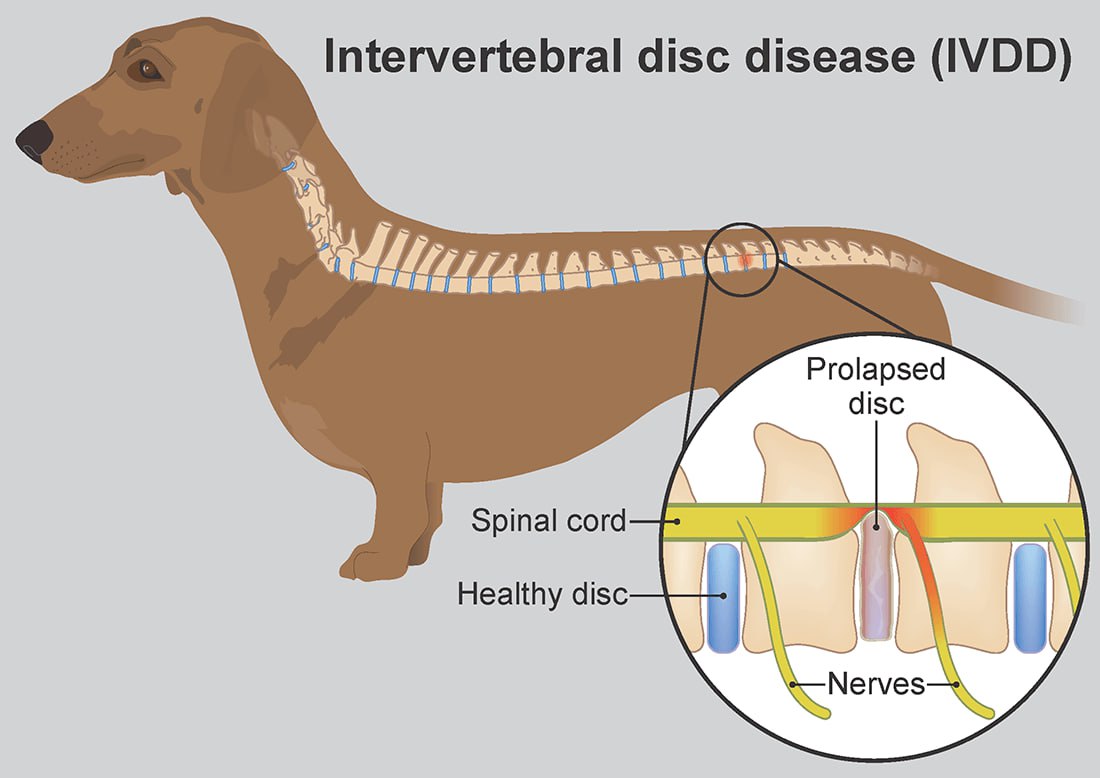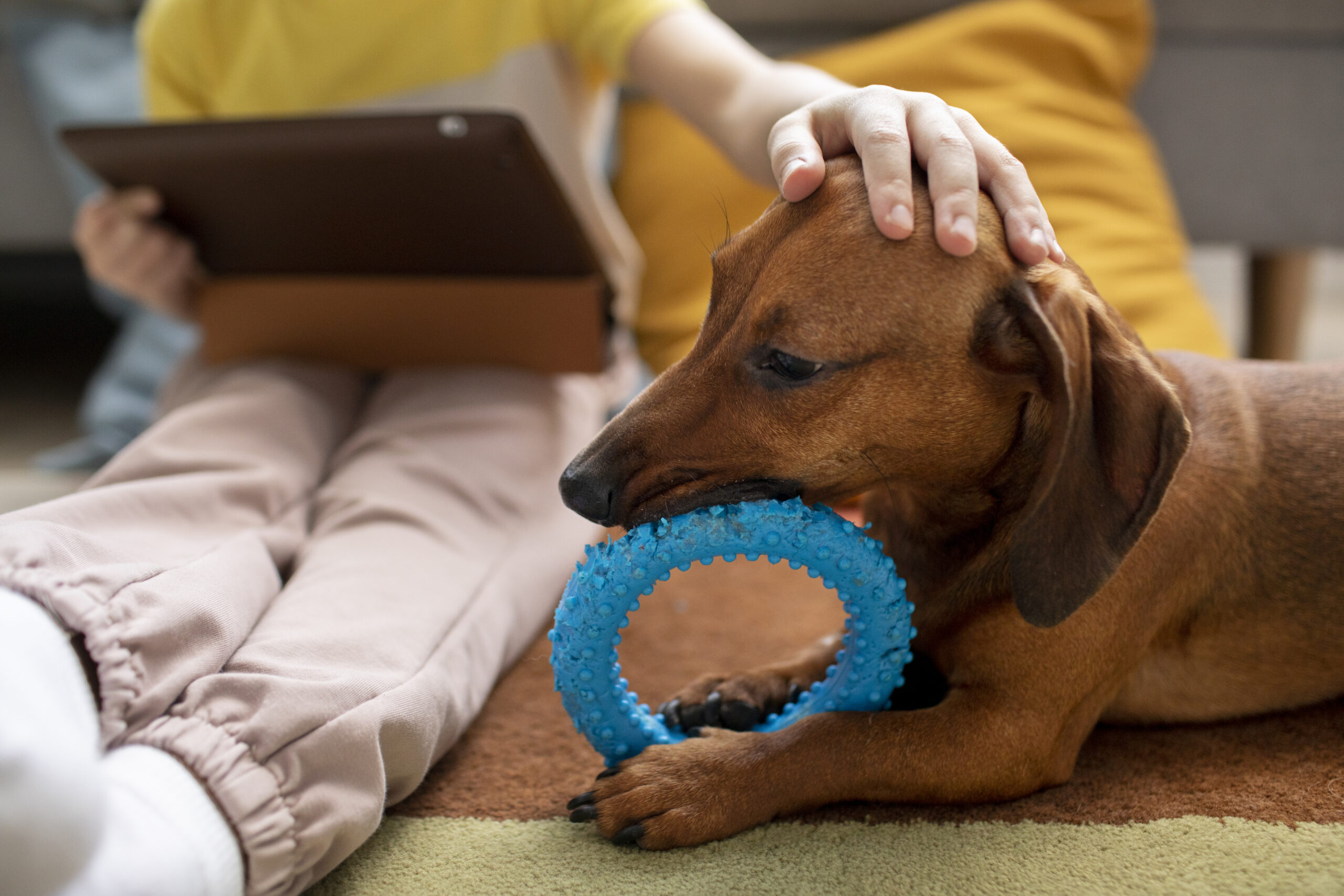Slipped disc in dogs (also called intervertebral disc disease or IVDD) can be one of the most painful and frightening conditions for pet owners to witness. Your pup’s sudden howls of pain are enough to send a shiver down your spine. Getting the correct diagnosis and treatment for a slipped disc can feel overwhelming. “What did you do?” “How did this happen?” At the end of the day, all you want is for your dog to feel better, fast.
Slipped discs in your beloved pup can be an incredibly distressing situation. You are afraid of the worst and hope for the best. In this guide, I provide all the information you need when dealing with a dog that has suffered a slipped disc. I cover everything, from the initial diagnosis to figuring out which treatments might be most beneficial throughout recovery.
Armed with this knowledge, you can quickly get a diagnosis and treatment plan in place, so your pup can start to feel better again. To begin, let’s explore the basics of slipped discs.
What Is The Mystery Of Slipped Discs In Dogs: Causes And Effects
In medical terms, Intervertebral Disc Disease (IVDD), slipped discs occur when one of the discs between your pup’s spinal vertebrae slips out of its normal position and presses on its spinal nerves.
Though the exact cause of this condition is not known, it is thought to be caused by an inherited genetic disorder that weakens the discs in your pup’s spine. It can also occur due to trauma or excessive jumping/running.
Age and weight are also contributing factors, as older dogs and overweight dogs tend to be more affected by slipped discs. However, any dog can be affected by a slipped disc, regardless of age and weight.
The effects of slipped discs in dogs can vary depending on the severity. Still, in general, they will experience pain and possibly paralysis if the disc is pressing on the spinal cord. In some cases, it could even lead to permanent neurological damage.
For more help about which food you should give to your dogs, you can check our post on: Finding the Best Dog Foods on Amazon. With a complete understanding of the causes and outcomes of slipped discs, it’s time to uncover the signs and symptoms of disc slippage in dogs so that you can give your pet prompt care.
Signs And Symptoms Of Slipped Discs In Dogs
Keeping an eye out for signs that your pup might be suffering from a slipped disc is essential. The faster you can diagnose it, the quicker you can begin treatment and minimise any permanent damage.
The signs and symptoms of a slipped disc vary depending on the severity, but here are some common ones to watch out for:
- Pain – Your pup may yelp or whimper when touched near their spine.
- Loss of appetite – Pain can cause your pup to lose its appetite.
- Unusual posture – Your pup may be trying to alleviate the pain by standing in an unusual position.
- Weakness or paralysis – If the disc is pressing on your pup’s nerves, they may experience weakness or even paralysis in their hind legs.
- Reluctance to move – Dogs with slipped discs may be reluctant to move because of the pain.
- Poor reflexes – If their nerves are affected, your pup may have slow or weak reflexes.
- Trembling – Pain and fear can cause your pup to tremble.
- Urinary incontinence – If the disc is pressing on their nerves, they may experience issues with bladder control.
- Shivering, shaking, and muscle spasms may also occur.
These are the main signs and symptoms of a slipped disc in dogs, so if you notice any of these, it’s essential to take your pup to the vet immediately.
A supportive environment, like providing a [Best Calming Dog Bed (Anxiety Comforting)], can ease your dog’s stress during recovery
Diagnosing Dog Disc Slippage: What The Veterinarian Will Do
Ah, the step to diagnose and cure this condition. It’s an essential step for both you and your pup, as not only will it rule out other conditions, but it will give the vet a clear picture of what is going on inside your pup’s body.
Here is what the vet will do to diagnose your pup’s disc slippage:
Physical Exam: Your vet will examine your pup and ask questions about their diet, exercise routine, and any other pertinent information.
X-rays: During the physical exam, your vet may order X-rays to gain a better understanding of the disc slippage.
MRI: The vet may perform an MRI to obtain a clearer view of the spinal cord and assess for any damage.
Blood Tests: Blood tests can help the vet rule out other conditions, such as cancer and infection.
Myelograms: Myelograms are a type of imaging test that can help the vet see if any disc material is pressing against the spinal cord.
If you notice any of these signs or symptoms in your pup, don’t hesitate to take them to the vet immediately so they can receive a prompt diagnosis and care.
Now that you have a good understanding of the symptoms, causes, and diagnoses associated with slipped discs in dogs, it’s time to check what treatments are available.
What are the Effective Dog Slipped Disc Treatment Options?
No one wants to see their puppy in pain, so luckily, there are various treatment options available for treating slipped discs in dogs. Depending on the severity of the disc slippage and the amount of nerve damage, your vet will determine which option is best for your pup.
Pain Medication
Your pup may be prescribed a pain reliever to help manage their discomfort. This can include anything from nonsteroidal anti-inflammatory drugs (NSAIDs) to corticosteroids.
Anti-Inflammatory Drugs
Common anti-inflammatory drugs prescribed for slipped discs are glucocorticoids like prednisone. These drugs help reduce inflammation and pain, but should only be given in short courses.
Physical Therapy
Your vet may recommend physical therapy to help strengthen the muscles of your pup’s back and neck. Engaging in regular exercise can also help improve posture.
Surgery
Surgery may sometimes be important to eliminate the damaged disc and relieve pressure on the spinal cord. This invasive procedure should be used only as a last resort if other treatments have failed.
For more information on how veterinary clinics handle surgical services, visit CityVet’s Surgical Services.
Can Dogs Heal Naturally? Disc Recovery Without Surgery
Not every case of a slipped disc requires surgery. Many dogs recover with conservative care, especially if the condition is caught early. Natural recovery methods may include:
- Plenty of Rest: Strict crate rest for several weeks.
- Medications: Prescribed pain relievers and muscle relaxants.
- Weight Management: Maintaining your pup’s healthy weight to alleviate pressure on the spine.
- Physical Therapy: Controlled exercises to rebuild strength safely.
What’s Next?
Now that you know the various treatments available for slipped discs in dogs, it’s time to take action. Consult with your veterinarian and discuss the options that are best for your pup.
Helping Your Pup Get Back on Their Paws
As pet owners, you must bear the responsibility of knowing how to look out for signs of slipped discs in your beloved canines and what you can do to alleviate their pain and suffering. Understanding the intricacies of this sometimes complex area of canine health will only strengthen our role as guardians.
Despite common misconceptions that a slipped disc is unusual or mysterious, diagnosing and treating them in dogs can be a manageable affair, one that often leads to full recovery when appropriately handled.
With some knowledge of pain management methods and preventive measures to strengthen the spine, pet owners can confidently arm themselves when caring for their pup’s needs. Together, we can make sure your four-legged friends have a chance to live life to its fullest. Additionally, for personalized assistance, feel free to contact us at pupzcornermail@gmail.com.
FAQs
Can dogs fully recover from slipped discs?
Yes, many dogs can recover with the proper treatment and care. The outcome depends on how early the condition is diagnosed. With consistent follow-up and preventive care, most pups can return to an active and happy lifestyle.
Is surgery always necessary for slipped discs in dogs?
No, mild to moderate cases often improve with rest, medication, and physical therapy. Surgery is usually recommended only for severe or advanced cases. Your veterinarian will guide you on the best course of action.
How long does recovery take after treatment?
Recovery can range from a few weeks to several months. Conservative care may take 4–6 weeks, while surgical recovery often takes 2–3 months with rehab. Each dog heals at a different pace, so patience and consistent care are key.
What breeds are most at risk for slipped discs?
Breeds with long backs and short legs, like Dachshunds, Corgis, and Shih Tzus, are most at risk, especially if they are older or overweight. Regular exercise and weight management can significantly lower the chances.






